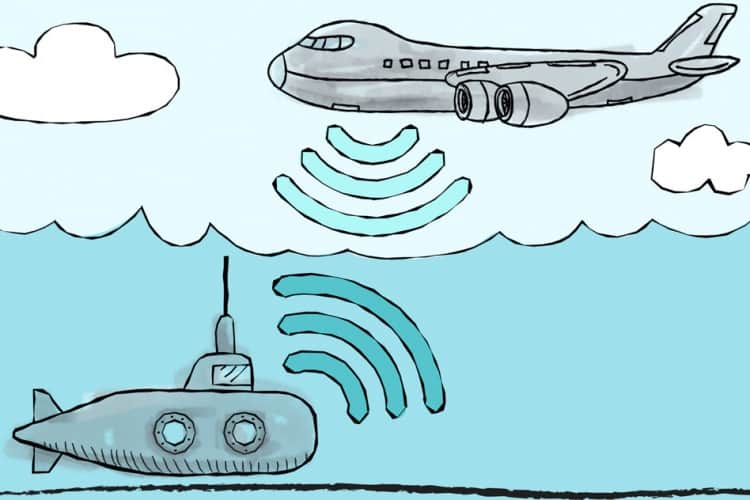
The development, which is still at a very early stage, could someday allow submarines to communicate directly with aircraft. Known as TARF (translational acoustic-RF communication), it uses a combination of sonar and highly sensitive radar to send and receive the signals. An underwater transmitter first sends data packets to the surface via sonar. Above the surface, the ultra-sensitive radar can detect the minute disturbances in the water, allowing the receiver to decode the data.
“Trying to cross the air-water boundary with wireless signals has been an obstacle,” said lead researcher Fadel Adib, an assistant professor in the MIT Media Lab. “Our idea is to transform the obstacle itself into a medium through which to communicate.”
TARF includes an underwater acoustic transmitter that sends sonar signals using a standard acoustic speaker. The signals travel as pressure waves of different frequencies corresponding to different data bits. For example, when the transmitter wants to send a 0, it can transmit a wave travelling at 100Hz; for a 1, it can transmit a 200Hz wave. When the communications signal hits the surface, it causes tiny ripples in the water, only a few micrometres in height, corresponding to those frequencies.
The radar, which resembles a pair of cones, transmits a radio signal that reflects off the vibrating surface and rebounds back to its source. Due to the way the signal collides with the surface vibrations, it returns with a slightly modulated angle that corresponds exactly to the data bit sent by the sonar signal. A vibration on the water surface representing a 0 bit, for instance, will cause the reflected signal’s angle to vibrate at 100Hz.
“The radar reflection is going to vary a little bit whenever you have any form of displacement like on the surface of the water,” said Adib. “By picking up these tiny angle changes, we can pick up these variations that correspond to the sonar signal.”
To filter the tiny sonar vibrations from the much larger waves surrounding them, the researchers developed signal-processing algorithms. Natural waves occur at about 1 or 2Hz — or, a wave or two moving over the signal area every second. The sonar vibrations of 100 to 200Hz, however, are a hundred times faster. Because of this frequency differential, the algorithm zeroes in on the fast-moving waves while ignoring the slower ones.
The communications system was tested in a water tank and two swimming pools on the MIT campus, with the sonar signals sent from depths of between 5cm and 3.5m below the surface, and the radar at heights of 20-40cm above the surface. TARF was able to successfully transmit data in all scenarios, even when confronted with small waves created by swimmers in the pool. In waves higher than 16cm, however, the system wasn’t able to decode signals. The next steps will involve refining the system to work in rougher waters.
“It can deal with calm days and deal with certain water disturbances,” said Adib. “But [to make it practical] we need this to work on all days and all weathers.”




Labour pledge to tackle four key barriers in UK energy transition
I'm all for clarity and would welcome anyone who can enlighten me about what Labour's plans are for the size and scale of this Great British Energy....